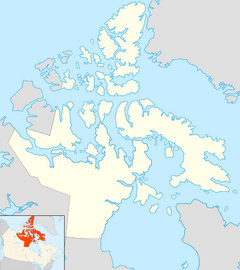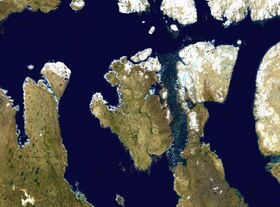Murchison Promontory
Topic: Earth
 From HandWiki - Reading time: 3 min
From HandWiki - Reading time: 3 min
Murchison Promontory ( [ ⚑ ] : 71°58′N 94°57′W / 71.967°N 94.95°W), a cape (promontory) in the northern Canadian Arctic,[1] is the northernmost mainland point of the Americas and of Canada.[2][3] Located 1,087 nautical miles (1,251 mi; 2,013 km) from the North Pole, it is 64 km (40 mi) farther north than Point Barrow, Alaska, the northernmost point of all U.S. territory.[4]
Geography

Murchison Promontory extends along the northern edge of the Boothia Peninsula, at right angles to the Bellot Strait, which separates it from Somerset Island. Situated in the Kitikmeot Region (Inuktitut: Qitirmiut) of Nunavut, its northernmost point, Zenith Point, is located at [ ⚑ ] 72°00′N 94°39′W / 72°N 94.65°W.[5][6] The nearest community is Taloyoak, approximately 250 km (160 mi) to the south.
History
The area was first explored in April 1852 by the Canadian Captain William Kennedy and the France explorer Joseph René Bellot while searching for traces of John Franklin's lost Arctic expedition.[7][8] The strait was then named after Bellot, who drowned the following year.
Irish-born Francis Leopold McClintock also wintered in the area with his ship Fox in the winter of 1858-1859 in his search for the Franklin expedition.[9] In July 1859, McClintock named the promontory, which his expedition determined to be the northernmost point of the mainland, after Royal Geographical Society president Roderick Murchison. Murchison was a prominent supporter of Jane Franklin in her efforts towards a continued search for her husband, which included the sponsorship of McClintock's expedition.[10]
In 1937 Scot E. J. "Scotty" Gall passed the promontory on his ship Aklavik on the first crossing of the Bellot Strait,[11] travelling from the western shore to the eastern for the Hudson's Bay Company.
References
- ↑ 1.0 1.1 "Murchison Promontory". Natural Resources Canada. http://www4.rncan.gc.ca/search-place-names/unique/OALDT. Retrieved October 10, 2019.
- ↑ Querying Geographical Names of Canada at Natural Resources Canada
- ↑ Murchison Promontory at the Atlas of Canada
- ↑ "The Northernmost Points In The United States". https://www.worldatlas.com/articles/which-are-the-northernmost-points-in-the-united-states.html. Retrieved October 10, 2019.
- ↑ "Zenith Point". Natural Resources Canada. http://www4.rncan.gc.ca/search-place-names/unique/OASFF. Retrieved October 10, 2019.
- ↑ "Somerset Island". Archived from the original on December 23, 2010. https://web.archive.org/web/20101223043232/http://www.oceandots.com/arctic/canada/somerset.php. Retrieved 2010-09-25. at Oceandots
- ↑ Francis Leopold McClintock at the Dictionary of Canadian Biography
- ↑ The Columbia Gazetteer of North America 2000
- ↑ Bellot Strait at The Canadian Encyclopedia
- ↑ McClintock, Francis (January 1881). Fate of Sir John Franklin: The Voyage of the Fox in the Arctic Seas in Search of Franklin and His Companions. John Murray. p. 276. https://play.google.com/store/books/details?id=ZuFKAAAAYAAJ&pcampaignid=books_web_aboutlink.
- ↑ University of Calgary, Scotty Gall
External links
 KSF
KSF

